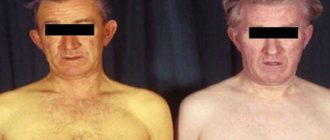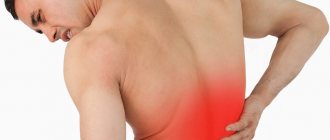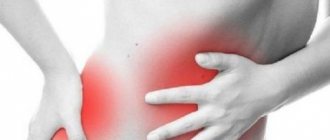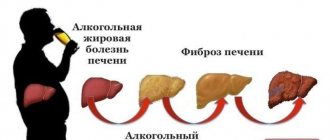If there is any pain, you should be wary, especially if it is pain in the right hypochondrium, radiating to the back. Such pain in the back under the ribs, like other soreness, means that a person is sick. Pathological processes pose a health hazard. Today we will look at some conditions in which the back hurts on the right under the ribs or the pain syndrome manifests itself on both sides.
Often, if there is pain on the left under the ribs in the back from the back or on the right, then pathological changes occur in the body, and there are also problems with the spine. A patient who is bothered by pain in the right or left hypochondrium, radiating to the back, needs to understand the nature of the pain and identify additional symptoms. So, the root cause of the pain will be determined, then the specialist will prescribe therapeutic measures.
How can it hurt?
Radiating pain can suddenly spread and be localized in various parts of the body, even if its source is far away. Subjectively, pain is perceived differently. A person can:
- Prick. This painful condition occurs during physical activity. In acute pancreatitis on the right side, there may be a stabbing pain on the back side, even if the person does not move.
- Burning, cutting, also causes acute pain. Such sensations occur with vertebrogenic pathologies and dysfunction of internal organs.
- Pull, whine. A person develops severe pathological changes.
- Sweep. Such sensations occur with pinched vertebrae, radiculitis, rheumatism and other problems. The lower back and lower thoracic spine are affected.
Therapeutic pathological conditions
When a patient is bothered by pain on the right under the ribs, and also feels nauseous, these are signs that the pancreas is inflamed; the pathological process occurs in acute or chronic form. The patient experiences an unpleasant sensation, and the pain syndrome will spread beyond the boundaries of the inflammatory process; there will be pain in the right hypochondrium from the back. The person is weakened and dysfunction of the gastrointestinal tract (GIT) occurs.
Dull back pain in the right hypochondrium with nausea occurs with pathological changes in the liver (hepatic cirrhosis, liver inflammation, malignant neoplasms). In addition to pain in the back on the right under the ribs, the following symptoms are observed:
- Yellow skin color.
- The patient is pale and weakened.
- He feels nauseous and suffers from dyspepsia.
- He is indifferent to food.
Pain on the right and side, after eating, occurs with an inflamed duodenum. Even with duodenitis, pain radiates to the back, scapular area. The person feels sick and vomits, he sweats a lot, is weakened, belches bitter air, and dysfunction of the gastrointestinal tract is observed. If there is pain under the right rib, there is a bitter feeling in the oral cavity, then such symptoms are typical for problems with the gallbladder and ducts that remove bile. The painful sensations will radiate to the shoulder area on the right, the person will have a feeling of burden on the right, he is weakened, and sometimes vomits.
If your side hurts, you should see a doctor.
Dull pain with distension occurs with chronic cholecystitis, and a person with stones in the gall bladder also suffers from such unpleasant sensations. The pain syndrome occurs cyclically, it is related to the time when the patient eats. Dietary nutrition will prevent such pains; they will occur less frequently and become less intense. Dull pain also occurs with gallbladder dyskinesia.
The gallbladder contracts poorly, the pain is stabbing and aching in nature. They will pass thanks to dietary nutrition and proper treatment. With pain on the right in the hypochondrium, the ducts that remove bile may be inflamed, and the inflammatory process will be localized in the duodenum proximally. With inflammation of the stomach, the pain syndrome is localized on the right under the costal area, and both diarrhea and constipation can be observed. The pain will go away within 2 hours after the patient eats or in the morning on an empty stomach.
Often pain on the right or both sides is a symptom of terminal conditions; the patient requires emergency assistance.
Pain due to pathologies of the gastrointestinal tract and kidneys
In acute cholecystitis, the pain syndrome is localized on the right, radiating to the cervical, right shoulder, and scapular areas. Severe hyperthermia is observed, the patient shudders, he is weakened, he feels nauseous, and vomits repeatedly. This pathology is associated with the presence of stones located in the gall bladder. They block the release of bile. In liver pathologies, the pain is sharp, occurs in paroxysms, and has a stabbing nature.
If the pathological process is on the left, then pain will appear in the left side
Liver colic occurs due to spasms, stones, and oncological processes. Due to the fact that the bile does not flow, the gallbladder is greatly stretched, and the patient vomits repeatedly. With kidney pathologies, pain may appear in the back on the right with irradiation to the genitals. Urinary excretion will be impaired, the patient will become weakened, and will feel sick. This pain syndrome is also characteristic of acute pyelonephritis. If the kidney is inflamed, urination will be impaired.
The causes of pain syndrome are that a person is sick:
- Chronic pyelonephritis.
- Renal polycystic disease on the right.
- Chronic pancreatitis.
- Inflammation of the kidney on the right side.
- Parasitic pathologies in the liver, bile ducts.
With renal colic, the pain syndrome is unbearable, located in the lower back on the right with irradiation to the groin. With hydronephrosis, the pain is similar to renal colic, but occurs in waves. With pyelonephritis and nephritis, severe pain on the right side and behind, similar to colic. The patient has hyperthermia, muscles and joints hurt.
The cyst is characterized by aching pain, occurs periodically, and grows. The patient has impaired urination and swelling. Pain syndrome from the right hypochondrium occurs in acute appendicitis, although the cause of the pain is located downward in the abdominal zone. It is reflected and felt under the costal area and up the abdomen.
Pain in pathologies of the heart and lungs
Pain in the subcostal area is a common symptomatic manifestation of pathology of organs located in the chest. She is observed:
- with pericarditis;
- myocardial infarction;
- pleurisy.
The problem area is recognized by identifying additional symptoms. If there is a pathological process in the organs located in the chest, then hyperthermia is observed, the person is weakened. He suffers from shortness of breath, he coughs often, and sometimes he has pain in his back under his ribs. With pleurisy, when a person swallows or hiccups, it hurts; it may hurt on the left under the ribs or on the left behind. Pain syndrome also occurs in acute pneumonia. To make a correct diagnosis, other symptoms are established:
- The patient coughs and produces sputum and pus.
- Hyperthermia, which appeared after the patient became hypothermic.
Oncology and traumatization
Painful sensations can be caused by a change in size of the diaphragm, which compresses other internal organs, hernias, diaphragmatic malignant neoplasms and their destruction due to trauma to the abdominal region.
May hurt due to injury
Pain in the right hypochondrium is caused by traumatic effects:
- Broken ribs.
- The liver is damaged.
- The kidneys and gall bladder are ruptured.
Also, pain syndrome can begin when a person turns sharply, bends over, or when organs come into contact with the ribs.
Pneumonia
In pneumonia, the inflammatory process affects the lungs. It can affect the alveoli and bronchi, and both the left and right sides can become inflamed. If the patient experiences pain from the right hypochondrium, from the back, then the right lung is inflamed. If the disease continues for a long time, then the person will experience pain from the back under the costal area and in the chest area.
With pneumonia, the body temperature can rise to 39.6 ºС, the patient will feel weakened, and physical and mental activity will decrease. Hyperhidrosis will also appear at night, appetite will decrease, the person’s muscles, joints and head will ache, and consciousness will be confused. At first, a person will suffer from a dry cough, which over time will become wet, shortness of breath will appear, and pain in the chest area may increase over time when inhaling.
Other signs of the disease will appear:
- Hyperemia of the skin on the affected side.
- Herpetic rash on the side where the lung is inflamed.
- Abdominal pain.
- The person will begin to vomit and lose bowel movements.
How is it diagnosed and treated?
If pneumonia occurs, then the help of a specialist in the field of pulmonology is required. He will collect anamnesis, examine the patient, and additionally prescribe an X-ray examination with fibrobronchoscopy, CT. Blood and sputum are also examined for the presence of bacteria, and a biochemical blood test is performed. Pneumonia is treated in a hospital under medical supervision. For treatment, antibacterial agents with vitamins, macroelements, expectorants, and bronchodilators are used.
Diagnostics
The primary examination is carried out by a gastroenterologist or a highly specialized hepatologist. During the physical examination, bladder symptoms, liver size, signs of peritoneal irritation and local tension in the abdominal muscles are assessed. If necessary, a consultation with an infectious disease specialist, gynecologist, or oncologist surgeon is scheduled. The diagnostic plan includes:
- Ultrasound of the hepatobiliary zone.
An ultrasound examination visualizes the gallbladder, measures the thickness of its wall, and identifies stones in the cavity. To confirm the diagnosis of dyskinesia of the gallbladder, a test with a choleretic breakfast is performed. An examination of the liver is necessary to study the structure of the parenchyma and find individual hyperechoic foci. - ERCP.
The study is indicated to assess the condition of the bile and pancreatic ducts and duodenal mucosa. Cholangiopancreatography allows you to take samples of material from pathologically changed lesions to examine them under a microscope for signs of cellular atypia. - Duodenal sounding.
The method is used to determine the contractile function of the gallbladder. Then portions of bile are subjected to microscopic and bacteriological examination. Analysis of the biochemical composition of bile is necessary when diagnosing cholelithiasis. - X-ray methods.
CT scan of the abdominal cavity is a highly informative method that helps to detect benign and malignant tumors of the hepatobiliary zone and parasitic cysts. The structural and functional features of the liver can be studied by scintigraphy. - Additional methods.
To determine the degree of fibrosis, rapid and non-invasive elastography is performed. For unspecified forms of hepatitis and neoplasms, a biopsy of the liver tissue is performed, followed by histological analysis.
Of the laboratory methods, a biochemical blood test with liver tests, which looks at the level of bilirubin, cytolysis enzymes, cholesterol and alkaline phosphatase, is of diagnostic value. To diagnose parasitic diseases, feces are analyzed for helminth eggs. To exclude the viral nature of pain in the right hypochondrium, serological tests are done for hepatitis A, B, C.
Ultrasound of the hepatobiliary zone
In pregnant women
In a pregnant woman, pain on the right under the costal area is associated with pathologies in the internal organs, and the cause may also be of a different nature. The expectant mother will experience pain due to the increased size of the organs, and they are displaced. In addition, pain may appear in the left hypochondrium from the back.
Pain in the back from the right hypochondrium may be dull
To exclude pathological processes, with frequent and long-lasting pain in the subcostal area of a pregnant woman, it is recommended:
- They undergo a medical examination.
- They donate urine and blood for laboratory analysis.
- They do an ultrasound.
Diseases of the urinary system
Many kidney diseases can cause pain in the back of the right side.
- Glomerulonephritis, hydronephrosis, kidney abscess and other pathologies are marked by aching, drawing, dull and sharp pain. The pain increases if you put pressure on the lumbar area.
- Stones in the kidneys. Renal colic (obstruction of the ureter by a stone) causes acute pain in the lumbar region, nausea, vomiting, and hematuria. Also, this type of pain may indicate renal artery thrombosis.
- Despite the fact that kidney stones account for about 30-40% of all causes of hospitalization in urological departments of hospitals, pain in the kidneys can also be caused by infection (pyelonephritis). The most common cause of kidney infections is bacteria (E. coli) that enter the urinary tract through the urethra. [4]
Osteochondrosis
With osteochondrosis changes, dystrophy occurs with degeneration of the discs located between the vertebrae. Back pain on the left side under the ribs behind or on the right side behind the back can be nagging and lasts a long time. Often, over time, a person’s back always hurts under the ribs, and the lower back is also painful. Symptomatic manifestations are extensive. The affected spine is characterized by stiffness of movement, the spinal column loses flexibility.
How to diagnose and treat?
Treatment is carried out by a neurologist. The specialist collects anamnesis and examines the patient. Additionally, X-ray examination, CT, and MRI are indicated. Therapy is aimed at reducing inflammation and pain. As a rule, they treat:
- Non-steroidal anti-inflammatory drugs.
- Chondroprotectors.
- Muscle relaxants.
- Vitamins and macroelements.
- Physiotherapeutic procedures.
Problems of the spinal cord, spine
Intervertebral hernia, osteochondrosis, spondylosis, pinched nerve roots - all these problems can cause sharp pain localized on the right side of the back. In order not to confuse spinal pathology with other diseases, it is worth studying other signs. A feeling of stiffness appears in the back, a pain attack increases with movement, radiating to the chest, limbs, and groin area. Numbness and “pins and needles” may also occur.
Severe pain is possible with a fracture of the scapula or ribs on the right. It is activated by coughing, deep breathing, and movements.
Spondylosis
With this pathology, spiky bone growths grow along the edges of the affected vertebrae. The pain syndrome is not constant, it can ache on the right under the ribs at the back, at the back under the ribs, in the lower back. The person feels tired, stiff, and the pain will intensify when weather conditions change. When a neurological examination has been performed, the doctor will prescribe an X-ray examination, CT scan, and MRI. Therapeutic measures are complex, symptomatic, physiotherapeutic procedures are used. Surgery is performed according to indications.
Muscles of the back or spine
According to the National Institute of Neurological Disorders (NINDS), 80% of adults experience low back pain on a regular basis. Most of this pain is caused by mechanical problems such as:
- Excessive stretching or tearing of a ligament due to improper lifting.
- Degeneration of the shock-absorbing spinal disc due to aging or normal wear and tear.
- Muscle tension due to poor posture.
Treatment depends on the cause and severity of your condition. Your doctor may initially recommend more conservative options, such as physical therapy or medications to reduce inflammation. If conservative treatments don't help or if your condition is severe, your doctor may recommend surgery. [1]
Pain with radiculitis
The soreness will appear unexpectedly and may disappear suddenly. When it appears again, it becomes intense. It will also intensify if you lift your straight leg while lying on your back. The leg will reflexively bend if a person wants to sit down from a lying position. Acute pain will appear when a person sneezes or coughs. The pain will intensify if you tilt your head forward. It is difficult to remain in one position for a long time, and if a person is motionless, the pain will subside.
It may sting in the side
At night, a person’s health worsens, he sweats, his face turns pale.
Neuralgia
If pain bothers a person between the ribs, then these are manifestations of neuralgia. This pathological condition is not only interconnected with vertebrogenic pathologies, but also with other underlying causes. Pain on the right side appears sharply and increases when the patient takes a deep breath. Also, the pain will spread not only from the front side, but also from the back.
If the pathological process is bilateral, then the pain will become encircling. A person feels “goosebumps” crawling longitudinally between the ribs, and the skin goes numb. During the examination, it is necessary to exclude cardiac pathology, in which pain syndrome may appear in the pericardial area.
Alternative Therapies
Corn silk helps with liver diseases
For various diseases of the gallbladder, the doctor prescribes preparations with immortelle.
The medicinal herb can be brewed with hot water and consumed as regular tea several times a day. The dosage should only be prescribed by a doctor.
For liver diseases, corn silk, rose hips and plantain are prescribed. The same medicinal herbs are prescribed for gallbladder pathologies.
In order to restore liver cells, decoctions prepared from milk thistle or hop cones are prescribed.
Milk thistle restores liver cells
Oat decoction is very effective in most pathological processes. It is recommended to take it after treatment of the liver and gallbladder.
Experts often prescribe mixtures containing knotweed, St. John's wort and chamomile. The duration of treatment is usually one month.
When does a person need help?
The ambulance is called in terminal conditions:
- Unexpectedly, there was severe pain in the side area; the pain lasted for 38–45 minutes.
- The person vomits bloody substances profusely, feels bitterness in the mouth, and hyperthermia appears.
- Pain increases during physical activity.
- The pain syndrome suddenly disappeared.
- Antispasmodic drugs do not help eliminate pain.
- Hematuria is observed.
- The patient became worse and became confused.
How to help, who will help?
Since pain on the right side, in the back area, is a symptomatic manifestation of dangerous pathologies, self-medication is contraindicated. The person must take a horizontal position and drink a tablet pain reliever. When pain appears, you should contact a specialist in the field of therapy. If necessary, he will refer you to other specialists involved in:
- Surgery.
- Gastroenterology.
- Cardiology.
- Gynecology.
- Traumatology.
- Infectious diseases.
- Endocrinology.
If the pill does not help, you need to urgently call an ambulance. Analgesics should not be taken in large doses, since the clinical picture of the disease will be distorted and it will be difficult to establish a diagnosis. Only qualified medical care will restore not only health, but also save lives.
How to treat referred back pain, which doctor to consult
Therapy is prescribed by a specialized specialist. To start, you can see a therapist. Treatment tactics are selected based on the underlying disease that was the source of visceral pain in the ribs. The gastrointestinal tract is examined and treated by a gastroenterologist. A hepatologist specializes in hepatobiliary pathologies. Vertebrogenic pain due to neuralgia and spinal destruction is relieved by a neurologist or vertebrologist. A urologist deals with dysfunctions of the urinary system. A gynecologist helps solve “women’s problems”.











